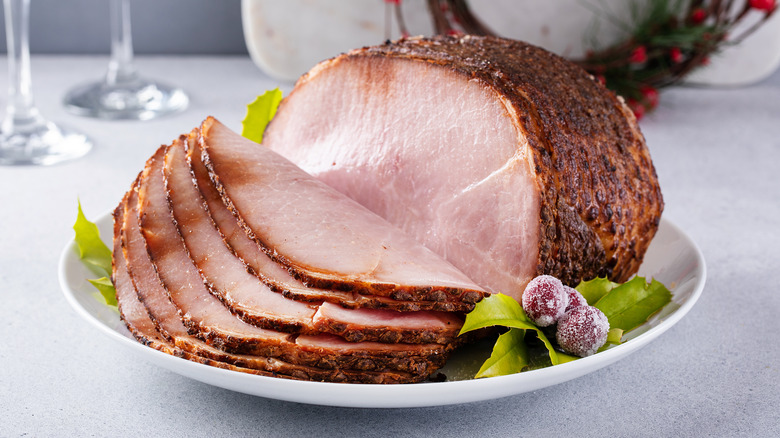Is Ham Considered Red Meat Or Something Totally Different?
The classification of ham is a topic of much debate among nutrition enthusiasts and food connoisseurs. While ham is derived from pork, a byproduct typically associated with the category of red meat, its many unrivaled characteristics leave some questioning its ranking. In fact, starting in the late '80s, pork was marketed as "the other white meat." But why are pork and ham's respective classifications so confusing? To unravel this conundrum, you first have to understand a few nuances.
First and foremost, it's a false fact that pork is white meat. It's actually a type of red meat, a classification generally identified as the muscle meat of mammals, particularly beef, lamb, venison, veal, and — of course — pork. These meats get their hue from myoglobin, a protein responsible for transporting oxygen in muscle cells. Myoglobin is richly concentrated in animals' frequently used muscles, thereby contributing to red meat's one-of-a-kind color and texture. Unlike fresh cuts of pork, ham is often prepared from the hind leg of the pig, a muscle group with naturally lower myoglobin content. The curing process, however, helps oxidize the myoglobin, contributing to ham's signature rosy tint.
Ham's categorization depends on a variety of factors
Curing and smoking can further alter ham's color, leading to its distinguishable, pinkish-beige appearance. These processing methods not only affect the color but also impact the meat's taste and consistency. Ham must undergo a curing process, in which it's treated with a mixture of salt, sugar, and various spices and seasonings. The addition of nitrites or nitrates during curing also plays a major role in ham's coloration, and smoking the meat imparts a spectrum ranging from pink to pale brown.
As with many other foods, meat classifications aren't solely based on scientific parameters but are also influenced by cultural perspectives — in essence, it depends on who you ask. In some traditions, for instance, ham is distinctive for its special curing and smoking processes. The culinary world often treats ham as a delicacy with its own trademark qualities.
Ham occupies a unique position that straddles the boundary between red and white meats, but understanding its biological makeup and the impact of curing, smoking, and societal norms helps demystify this dilemma. Whether or not ham is considered red meat hinges on an interplay of science and personal interpretation within the rich mosaic of delicatessen gastronomy.

